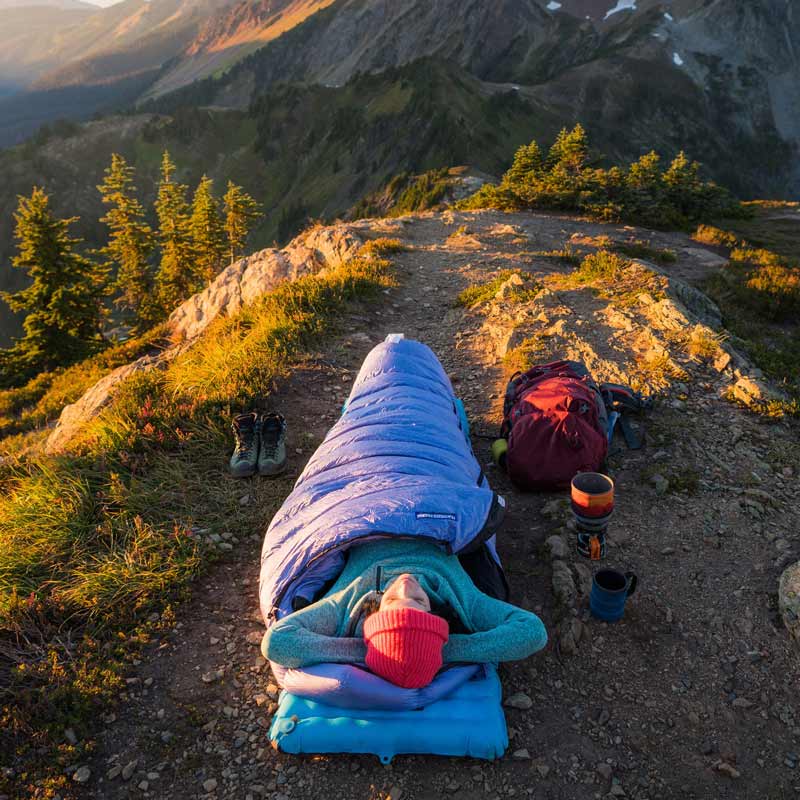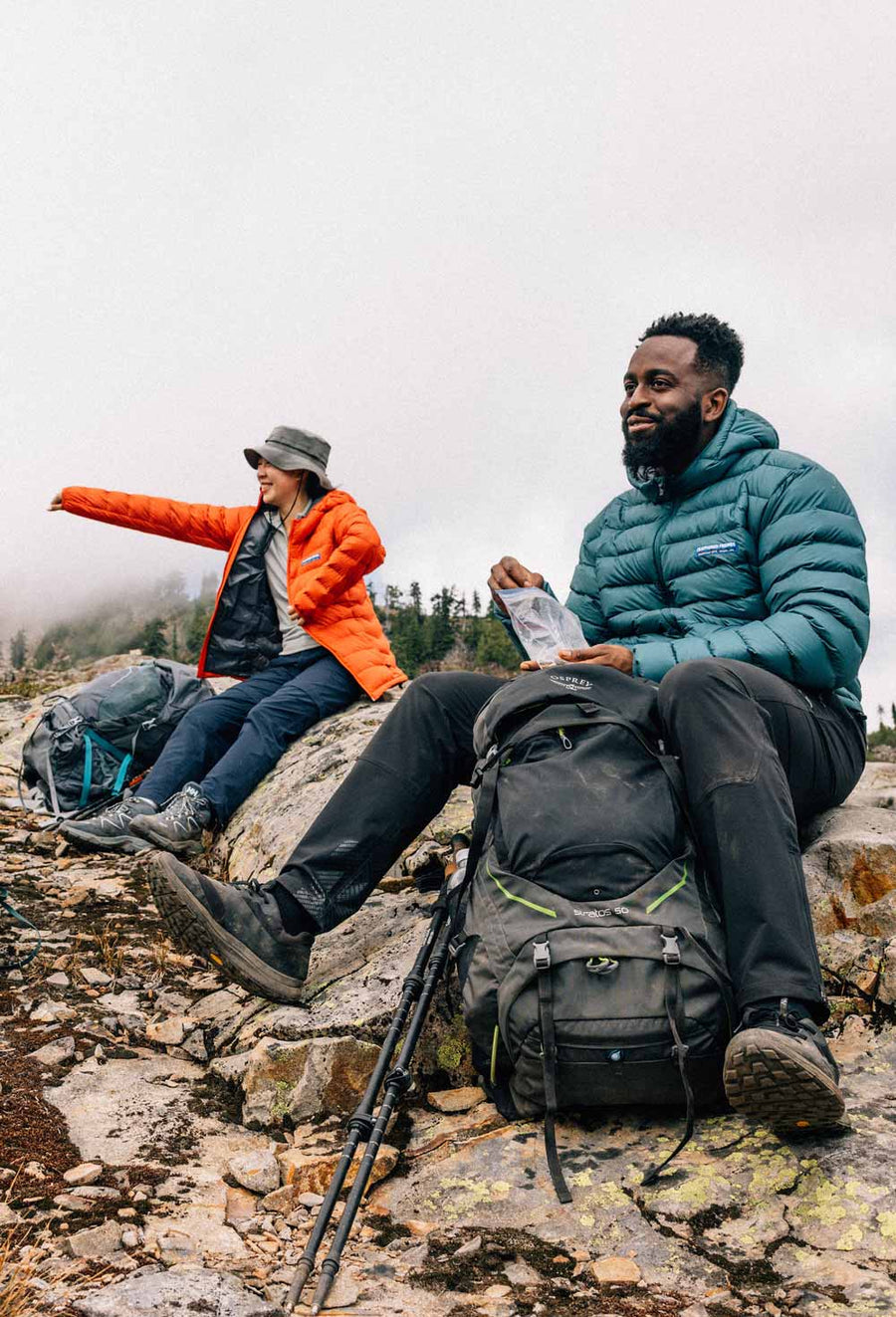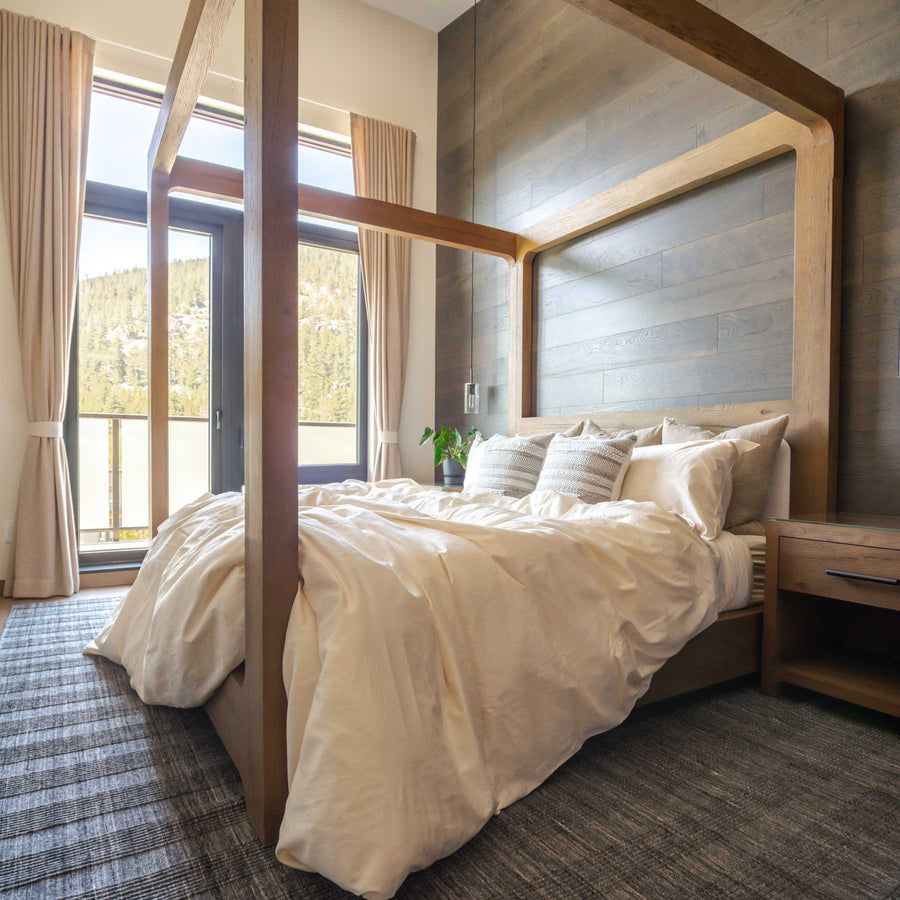The Case for a Sabbatical: A Gap Year for Climbing

The year 2020 has been the first Gap Year for married Alpinists Jeff and Priti Wright, whose alpine pursuits have until recently been relegated to three weeks of vacation per year. For the past two years, they have planned and saved for their Sabbatical. This article will cover some of the lessons and steps for planning your own Gap Year. Words and images by Jeff and Priti Wright. Additional photos by Tom Evans and Ben Stone, as credited. Keep up-to-date via their blog: www.alpinevagabonds.com

Priti at the base of the Franco-Argentina Route of Fitz Roy, Patagonia, Argentina during a successful 9-day door-to-door Smash ‘n Grab
Alpinism on the world’s finest peaks has changed dramatically over the past few decades, allowing some major alpine objectives to come within reach for non-professional climbers. The accessibility of the alpine has increased over the past few decades with more reliable weather forecasting (even in Patagonia) and the development of infrastructure deeper into the Hills. Advancements in SOS devices and rescue operations have made it safer for us to go faster and lighter.
No longer does a Patagonian expedition require river fording, mule packs, and months of waiting out the planet’s nastiest weather under ramshackle boxes. Even an ascent of Fitz Roy can be done in 9 days Seattle-to-Seattle and Cassin Ridge 10 days Seattle-to-Seattle with moderate forecasting prowess along with skills honed in our backyard, the Cascades.

Jeff straddling the Cowboy Arete on Denali’s Cassin Ridge during a successful 10-day door-to-door Smash ‘n Grab
Transition from Smash ‘n Grab to Gap Year
We’ve spent years honing our Smash ‘n Grab skills in the Alps, Patagonia, Alaska, and at home in the Cascades. It relies on modern weather forecasting, knowing current mountain conditions from afar (often through Instagram hashtags), and buying last minute plane tickets to catch the peak weather window. This optimizes not just our chance of success, but (more importantly) the amount of vacation time burned. This model has been very successful for us, and has taken us to many far-flung objectives over the past few years.
To be clear, the objective for us as career professionals (engineering and software) was not to get in and get out of the mountains as fast as possible (because that’s pretty lame!), but to make our limited time in the mountains as productive as possible. However, there is undoubtedly much additional value to be had when you spend extended periods of time in the mountains or mountainous regions; same as if you spent a weekend versus a month in a big city like Paris.

If looks could kill. Priti and the ‘Lady Killer’ near Golden, BC (Feathered Friends Ellia Down Jacket). Photo: Ben Stone
Take El Chaltén or Cochamó for example. When you spend extended amounts of time there, not only do you get to experience the richness of the Patagonian culture, language, and cuisine, but you also get to understand the weather patterns, the changing mountain conditions, and the spirit of the mountains. You even get to dive into the particular Climbing Culture of a particular area including the ethics, community, and how it is ingrained in the larger culture.
One important note regarding the Sabbatical model is that you are not necessarily increasing your chances of success in terms of climbing, but you’re simply altering your lifestyle and goals for a trip. When we showed up in Patagonia in mid-February 2019 for the splitter window of the season, many folks were just catching their pre-planned flights back home after being in town for weeks and months with no significant weather windows. That’s why we’ve established that our goals for our Sabbatical would be more lifestyle-oriented as opposed to summit-oriented.

Waking up on the summit of The Eiger in our pair of Feathered Friends Vireo Sleeping Bags after climbing the North Face via the classic Heckmair route
Find Inspiration
There is a TED Talk by Stefan Sagmeister that inspired us: “The Power of Time Off”, which explores his philosophy of embedding Gap Years into your career path. This lifestyle is completely antithetical to “Retiring Early” or “4-Hour Work Week”. For 10 years, we had casually toyed with the idea of taking a Gap Year some day. It wasn’t until 2 years ago when we actually made a plan that the wheels started turning.
Of course, the impetus to get serious about a Sabbatical for us was not just Sagmeister, but also a barrage of close friends hogging our Instagram Feed with their own Gap Years actually happening! It was time to turn FOMO (negative) into inspiration (positive).
The idea of prioritizing experiences over materials transcends generational differences. It is theoretically possible to still have a successful career, a family, a house, and also take recurring, interspersed Sabbaticals instead of bundling them all up into Retirement. We personally know several families who have successfully taken the whole gang on extended trips to learn new cultures, languages, and broaden their kids’ horizons. It’s about collectively experiencing something together, for an extended period of time. Those experiences don’t have to be big and international, either. Hone your woodworking skills, build out that van, or spend time at your local crag to finally send that 5.12.

Halfway up the classic 5.11 dihedral on All Along the Watchtower in the Bugaboos
Goals-Expectation-Style
As alpine climbing instructors, we teach the importance of discussing these items as a team for each trip. This is especially important to discuss if you're travelling with somebody else (but still a good exercise to do solo).
- Set the goals. This is all the optional stuff; the desired outcome. What’s the reason for your Gap Year in the first place? What are your favorite mountains or cities that you want to visit?
- Establish the expectations. This is the mandatory stuff. When do you have to go back to work? What level of safety are you OK with (i.e. no countries with Level 4 travel Advisories, etc)?
- Then agree on a style. Extended stays vs continuous travel? Climbing vs museum-hunting? Camping vs Airbnbs? Bouldering or Alpine Climbing? Compromise and negotiate so that it is fun for everyone involved.

Priti bouldering at The Baths on Virgin Gorda, British Virgin Islands (speaking of style, it doesn’t have to be all ice and snow!)
Make a Plan
Making a plan is very simple, but it is the MOST SERIOUS STEP:
- Draft the Itinerary.
- Where do you want to go? How long? How many destinations?
- Are you living out of your Subaru and travelling to America’s rad crags or are you going international and staying in hostels/Airbnb’s?
- Do you want to have extended stays (our personal preference), or do you want short stints in more destinations? Generally, extended stays are less expensive and less stressful than moving around a lot. Plus, you get to absorb the culture/language/mountains a bit more.
- What is your target start date for your Sabbatical? Having a goal and a date circled on the calendar provides a lot of incentive to start saving.
- Draft the Budget.
- Put together a draft itinerary and budget, then add a factor of safety, maybe 15% or even up to 50% (depending on how flexible your end date is). There are sure to be a few unexpected expenses!
- Do you think you’ll break even on renting out your home or condo? Start understanding the rental market, if this applies to you.
- List out all of your bills and determine your discretionary income...this is a spectacular exercise that we had never done until planning for our Gap Year. Make sure you understand what all of your annual expenditures are, especially those sneaky ones like taxes and car tabs (and Netflix).
- Next, figure out how much you can cut back to funnel into Savings. The key here is not to have a drastic change in your standard of living. You can’t drastically change your lifestyle and start eating rice and ramen for every meal. You’ll probably burn out and abandon your plan.
- Once you determine how much you can save, calculate how long it will take you to save up for your Gap Year plan.
- Other expenses to consider for your Gap Year: long-term storage, virtual mail delivery, travel/health/rescue insurance (or self insure?), cell phone plans, flights, vaccinations, medications, etc.

Priti sporting the Feathered Friends Volant jacket near the summit of Denali
- Iterative Process.
- Repeat steps 1 and 2 until you reach equilibrium. Maybe you decide to include less expensive destinations on your Gap Year. A few bucks a day can go a long way in SE Asia!
- Other variables: Maybe your Gap Year is a Gap 6-Months instead, or the start date moves around.
- Do all of this planning in one sitting! Literally, don’t get up until you have a good Draft Plan.
- Would you rather start your sabbatical sooner and take less time off, or do you have the fortitude to stick to a plan for 5 years? For us, two years is about the maximum we can dedicate to a specific plan. Any more than two years of scrimping and saving, and we would get distracted and abandon the thing altogether. You never know what could happen in two years (like global pandemics or Spanish Inquisitions).

Standing on the summit of Cerro Torre...a top goal for the Gap Year
List and Prioritize your Goals
Some dreams come first, some go on a Kmart layaway. Don’t just list your climbing goals, but sprinkle in some other goals like: get abs, learn a language, do a handstand, absorb culture, meditate/pray (also maybe eat and love), get abs, educate yourself in a certain area, learn an instrument or a new sport, build your relationship with your travel buddy or significant other (if applicable), or just get abs.
Save Save Save
Stay on budget! You have a new discretionary income that is now significantly reduced from before (or maybe you were just winging it before). If you want a shiny new cam during the Saving phase, make sure it gets absorbed and doesn’t eat into your Gap Year budget. If you want a new climbing rope, maybe switch to eating ramen just for a week or so. Just make sure it gets absorbed into the plan. Stick to the plan!
Also, stick to the f’ing plan.
What is a Sabbatical?
We’ve been sloppily interchanging the phrases Gap Year and Sabbatical in this blog post; and indeed they are sort of interchangeable. Of course, your time off doesn’t need to be a year. It can be more, or less. And it doesn’t need to be time off that’s officially sanctioned by your employer, as the definition of Sabbatical implies. You can always just quit!
Still, a Sabbatical infers something much bigger than a vacation or just “time off”. A Sabbatical is personal enrichment, professional development, bigger mountains, harder routes, more dedicated training, etc.

The Eiger Summit
But Wait...My Career!
How disruptive is this for your career? Maybe 3 months is equally disruptive and awkward as a year, so why not take a year off? Check if your company offers a Personal Leaves of Absence. Companies are more and more beginning to offer these formally. Small startups may offer these informally. A Sabbatical may come after many years with the same company, or at a time when you are between careers or considering a big life change.
Start the conversation early with your manager, especially if you want to come back to the same team. Don’t complain to your boss about being “burnt out.” Instead, keep the conversation positive, discussing the benefits to your own life and maybe even the company. Could you potentially help alleviate temporary headcount pressures?
You want to be invaluable but not indispensable.
Continue networking while on your Gap Year. Keep in contact and don’t be a stranger. Let your coworkers know how you’re doing, and that you’re looking forward to coming back (even if you have to grit your teeth while saying it).
Update your resume before you go. You’ll forget everything you’ve done within the first week of your fun-employment.
Develop a plan for covering your responsibilities while you’re gone. Start to wrap up loose ends.

Summiting every peak during the second ascent of the Southern Pickets Traverse, North Cascades
Retirement/Savings Plan
If you already have a retirement goal, understand how the Sabbatical will affect your retirement account, if at all. If you don’t have a goal, do this now! Will this affect your retirement date? If you were planning to retire early, maybe you now need to work a little longer. Consider the time value of money: One year of not working when you’re 30 doesn’t mean that you’re taking one equal year away from your retirement age. If you have no idea about retirement, consider seeking out a Certified Financial Planner to run retirement scenarios for you.

Priti jugs up the Great Roof as fast as she can, while Jeff short-fixes the next pitch (Pancake Flake) on the Nose-in-a-Day, El Capitan, Yosemite. Photo: Tom Evans
Partners
We’re lucky enough to have each other as legally bound climbing and travel partners. If you’re flying solo, or have friends meeting you intermittently, fear not! It’s surprisingly easy to find climbing partners abroad. Just remember that with new partners, it’s especially important to establish your Goals-Expectations-Style ahead of time. Make sure they know how to tie a figure 8 before you show up at the base of an alpine route!
Give Back
Find good charities to support while on your adventures, especially supporting the places that you’re visiting. Seek out volunteer opportunities. Maybe you’re supporting re-bolting efforts in Thailand, or local schools in Nepal, or mountain rescue operations in Patagonia. Remember, this is a Sabbatical, and it’s more than a vacation. Use this time to enrich your life and the lives of others.

Priti near the summit of Fitz Roy, Cerro Torre and the Hielo Continental behind
Our Gap Year
- January-February: El Chaltén, Argentina to get our butts kicked in the finest collection of peaks on the planet.
- March-June: Chamonix, France to hone the alpine skills in the world’s alpine playground. Or just do a lot of running because we’re in confinement.
- July-September: Karakoram, Pakistan. Game time. Try to do something big!
- October-December: Southeast Asia to sit back and clip some bolts (and put our feet in the sand).
The Socials
Follow along on Instagram:
- @jeff_t_wright
- @prittyright
Keep up-to-date with our blog: www.alpinevagabonds.com

The “Death Bivouac” on The Eiger’s North Face
Current Status
As we type here in April, 2020, we are currently holed up in our Chamonix bunker under mandatory nationwide French lockdown from March 20 through May 11 (if it doesn’t get extended). We’re still hopeful that we can get to Pakistan in July. As of now, none of our Sabbatical plans have changed.
January and February were fruitful in Patagonia. We were lucky to get enough weather windows to get into the mountains about once a week ticking five Patagonian summits (including Cerro Torre) and failing on three other summits (due to weather).
March was filled with a few good weeks of skiing in Chamonix and a successful ascent of The Eiger North Face just before lockdown.
Let’s all stay safe and keep it chill. We’ll all get back into the mountains before we know it!
Peace,
Jeff and Priti

Sleeping soundly on Mount Waddington. Feathered Friends Spoonbill Sleeping Bag








Leave a comment